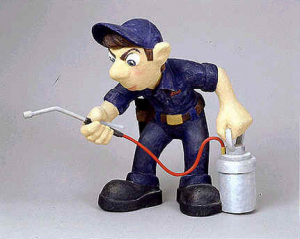 Some of the best advice you’ll ever get from pest control guru’s is to always inspect first, treat second. Sage advice at least on paper. Over the years I can’t tell you how many times I’ve read this, been told about it or even been reprimanded for not doing a good enough inspection. (once) It’s such an important part of being a pest control professional and I agree. (to a point) The reasons I’ve always been taught to inspect first were;
Some of the best advice you’ll ever get from pest control guru’s is to always inspect first, treat second. Sage advice at least on paper. Over the years I can’t tell you how many times I’ve read this, been told about it or even been reprimanded for not doing a good enough inspection. (once) It’s such an important part of being a pest control professional and I agree. (to a point) The reasons I’ve always been taught to inspect first were;
*To identify the pest
*To determine if it’s a chronic, sporadic or potential problem
*To map out a strategy of how to deal with it
*Find areas of sanitation needs
*To get more info from client (if present) in order to better understand the issue and set out reasonable expectations based on what you find
*To make your treatment more effective
Now, ALL of these are good and they make for an impressive ‘to do’ list in the industry hand books and trade magazines and even in the company policy manual. The articles are first rate, well written, hard to argue with and from some of the most respected names you can imagine. The ‘inspection first’ seems to be the answer for any situation and everything is pretty cut and dry, black and white. Find this do that, see that expect this. A + B = C. I’d say for the most part, we as an industry accept this standard as normal operating procedure, but is it practical in the real world of a busy tech? Is there a time when we all have to do treatspections?
What Is A Treatspection?
First of all, you won’t find the term in any dictionary or field manual so if catches on, you can tell people you heard it here first. A treatspection is basically an ‘inspect as you go/treat’ approach. It’s also the way I’d say most technicians do almost every single job. Flashlight in hand (hopefully) you’re looking for all of the elements described above but you’re applying your treatment right along with it. See a few roach droppings in the cabinet, out comes the bait gun-a mouse in the garage and you’re on it with a sticky trap from your tool pouch. There is not a lot of strategic planning or set up as you might have with your traditional ‘inspection first’ approach.
Treatspections work well for a hectic schedule and let’s face it, technicians are busy people and it’s not unusual for them to have 10, 15 or even 20 stops in a day and the boss wants these tickets done! Taking time to inspect? Not gonna happen.
Since It’s A Reality – Let’s Be Good At It
So the treatspector has to be extra sharp and thinking through his entire service. Little things have to grab his or her attention and they have to be good at quickly piecing bits of information and evidence together. Treatspectors need to have more than one tool handy at all times in order to briskly, safely and most efficiently handle what ever comes up. Treatspectors with just one tool (B&G or just a bait gun for example) aren’t treatspectors–(call em what you will)
I’m don’t get heartburn when I observe a tech who wiskd through a home doing a treatspection. It’s been going on for a long time and it will continue as long as we insist on scheduling so much work in a day and that won’t be changing anytime soon. Oh & let’s not forget the hurried client either–they don’t expect much more than a quick spray most times and they’ve got things to do too.
Just as long as while we go, we’re giving that client our best, keeping our eyes and ears open and taking the time if and when need be—to get the job done right.




